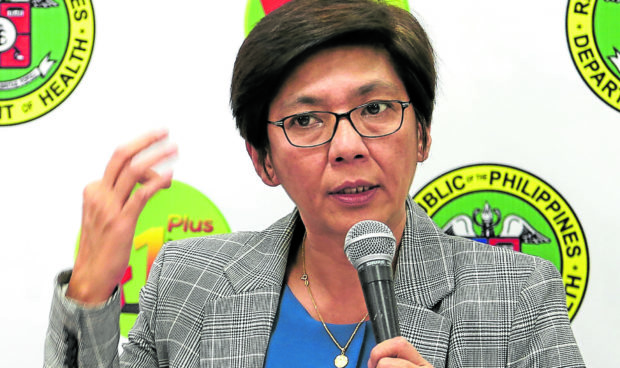
Health Undersecretary Maria Rosario Vergeire. INQUIRER file photo / EDWIN BACASMAS
The Department of Health (DOH) on Wednesday said it would be wrong to call Davao City the new “epicenter” of the COVID-19 pandemic in the country, despite a spike in cases there.
In a message to reporters, Health Undersecretary Maria Rosario Vergeire rejected the term, saying it may lead people to believe that the uptick in cases originated from that area.
“No, Davao City is not an epicenter. We continue to closely monitor the situation in Davao City due to increasing cases,” Vergeire said, adding that the DOH “discourages” the use of the term.
“Epicenter, in relation to epidemics, are interpreted by some to refer to an area as the source of the infection. It is also meant to connote the area as a hotspot for the infection. We discourage the use of the term ‘epicenter’ in describing the rise of cases in an area,” she said.
But Vergeire also said: “Select National Capital Region areas as well as Davao City were among our flagged areas because these had high risk case metrics and high to critical risk health care and ICU utilization rates.’’
However, when asked if she can categorically say that Davao City has surpassed Metro Manila as the hardest hit area, Vergeire declined to make that distinction.
“We do not compare counts alone as they are all of equal importance based on these metrics,” she said.
‘Yes, I believe so’
But Davao City’s acting health officer, Dr. Ashley Lopez, admitted that the city had become one of the COVID-19 epicenters as cases continued to rise, triggering localized lockdowns in at least 26 private establishments.
“Yes, I believe so,’’ Lopez said when asked if he agreed with Octa Research’s assessment.
Independent research group Octa Research said in its June 8 report that Davao has surpassed Quezon City in terms of average number of new Covid-19 cases in the past seven days. From June 1 to 7, Davao City recorded 213 average new cases, a 44 percent increase from the 147 average new cases from the preceding week, while Quezon City recorded 207 new cases, which was lower than the 283 cases a week prior.
Octa research fellow Guido David said Davao City, along with Western Visayas can also be considered epicenters, in addition to NCR.
Davao City posted 244 cases as of 5 p.m. on Tuesday, bringing to 2,683 the total number of active COVID-19 cases, according to the City Health Office (CHO).
“It is shown in our data based on the growth rate, the average daily attack rate (Adar) and other indicators. Davao City was even escalated to modified enhanced community quarantine (MECQ) based on the risk classification of the local government,” Lopez said in a text message to the Inquirer.
Lockdown
On Monday, 26 establishments and offices including call centers, shops, banks, food establishments and churches have been placed on lockdown as the DOH documented 1,924 cases here in the past 10 days alone.
Dr. Marjorie Culas, assistant city health officer of Davao, also said majority of the detected transmissions in the city were within workplaces, establishments and households.
“Among the most affected are business process outsourcing (BPO) or call centers. As of this time we have reported 11 BPOs that have cases,” Culas said on Monday.
“We have a certain BPO company where [during] surveillance, 403 tested positive of the 1,000 employees who were tested. That is very very high already,” Culas said.
The city government earlier ordered the temporary closure of five call centers because of the high number of COVID-19 cases in their workplaces.
Lockdowns were also declared in several government offices including the city’s Sangguniang Panglungsod Building, where at least 44 employees tested positive for COVID-19.
54K active cases
On Wednesday, the DOH said it recorded 7,854 new Covid-19 infections, which brought the country’s total case count to 1,286,217 cases.
The DOH said there remain 54,000 active cases or currently sick individuals. Another 7,854 individuals have recovered from the illness, which brought the total number of survivors to 1,210,027. However, another 126 have died, bringing the total death toll to 22,190.